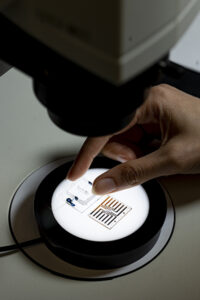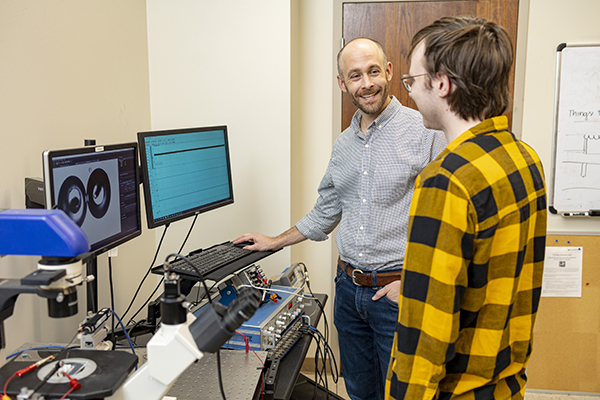By Izzie Gall. Photography by Shawn Poynter.
 James Conklin Fellow and Associate Professor Andy Sarles wants to make a microchip that can talk directly to your cells.
James Conklin Fellow and Associate Professor Andy Sarles wants to make a microchip that can talk directly to your cells.
Over the last decade, the area of “neuromorphic” engineering—which takes inspiration from the structure and function of biological brains—has been gaining traction. It is a subfield of “biomimetic” design, which emulates the structures found in nature.
Rather than trying to recreate brains from scratch, neuromorphic engineers look at the way biological systems use networks of neurons (nerve cells) to react to and remember stimuli, and then try to build artificial systems that work similarly.
“While recent neuromorphic devices have some brain-like qualities, like physical memory storage, most emulate only a few basic properties of brain cells and networks,” said Sarles. “Furthermore, they are usually rigid and operate electronically. This limits their ability to interface with biological cells or tissues, which are soft and wet and communicate via ionic and chemical signaling.”
For Sarles, whose lab focuses on engineering biologically inspired systems, the next step is clear—if not exactly simple.
“We aim to develop new types of hybrid devices that both integrate the sensing and neuromorphic computing functions and enable direct communication with living cells and tissues,” Sarles said. “These new hybrid biomolecular synapses will be able to sense signals, incorporate those signals into their computations, and then communicate with each other or with cells, just like a biological neuron or synapse.”
In biological systems, neurons are responsible for collecting sensory signals triggered within an organism’s body or by the outside environment, then transmitting those signals to the brain. Specialized gaps between neurons, called synapses, regulate how neural signals pass through the network. Synapses also dynamically adapt to these signals, thereby establishing a memory of prior activity that can shape future actions.
“Current neuromorphic devices predominantly use solid-state electronic materials that only respond to generic bioelectrical potentials,” said Sarles, referring to the electrical pulses generated by living cells. “We want our artificial synapse devices to be able to sense both ionic and biochemical signals that are released from nearby cells, and then process, learn from, and remember those signals.”
Sarles’ proposed “hybrid” synapse would integrate biomolecular sensing with neuromorphic processors made from synthetic materials to broaden the set of information available to the device. Observing both biopotentials and biomolecular signals could expand the ways scientists can monitor cell health, monitor biomarkers of disease, or even verify drug delivery to certain tissues.
The tricky part will be integrating “wet” or biocompatible materials with the solid electronics currently being used in neuromorphic devices.
Fortunately, Sarles’ project has caught the attention of the US Air Force, which has given this ‘tricky’ issue a substantial boost.
The Air Force Office of Scientific Research (AFOSR) furthers the US Air Force’s goals to secure and fully utilize the nation’s air, space, and cyberspace assets.
One of AFOSR’s Chemistry and Biological Sciences programs, Mechanics of Multifunctional Materials and Microsystems (MMMM), focuses on the production of materials that integrate newly emerging technology. MMMM holds particular interest in systems that are able to sense, understand, and respond to stimuli on their own—like Sarles’ proposed hybrid device.
The AFOSR has granted $4 million over the next five years to Sarles and his coinvestigators, Professor Yong Chen at the University of California Los Angeles and Professors Jonathan Rivnay and Neha Kamat at Northwestern University.
To construct their hybrid device, the researchers plan to couple a soft, thin, semiconductive polymer with a biologically derived membrane that closely resembles a cellular membrane. This biomimetic interface will be equipped with various stimulus-responsive proteins, either harvested from living cells or synthesized in a lab.
That modular design will make it possible to swap sensory proteins and transport channels into the membranes as needed to tailor the devices for specific tasks.
“We hypothesize that integrating these components will lead to a new class of neuromorphic devices that can distinguish multiple types of physical stimuli at the interface of living cells and tissues,” said Sarles. “When coupled with neuromorphic signal processing and memory, this functionality will allow the device to learn and compute in real time.”
Ultimately, Sarles hopes the project will result in implantable or wearable “smart bioelectronics” that bridge the gap between synthetic and biological materials.
“By integrating more of the capability seen in actual neurons,” Sarles said, “we hope to transform the way our devices monitor, predict, and control biological activities. This type of hybrid device could potentially change how we diagnose and treat diseases and injuries.”
